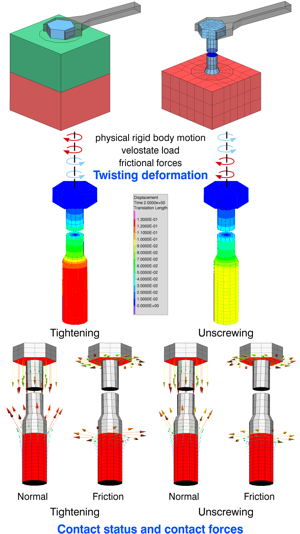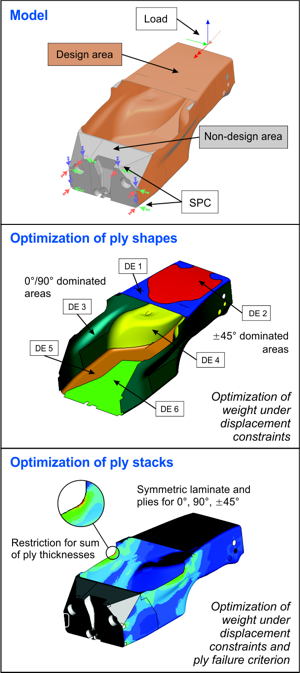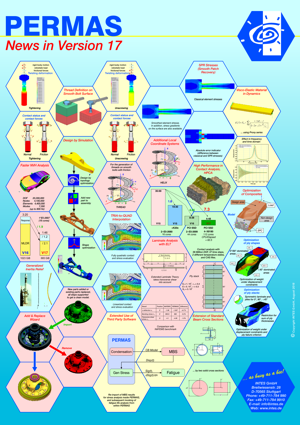New Features in PERMAS Version 17
The new Version 17 of PERMAS is the result of about 24 months of development work.
For a complete and detailed overview on changes, a Software Release Note
is shipped with Version 17.
Great effort has been spent in the past years to provide with
VisPER (i.e. Visual PERMAS) a dedicated tool to improve pre- and
post-processing for special PERMAS functions. The sixth regular
VisPER Version 6 is released at the same time as PERMAS
Version 17.
PYTHON is now the standard scripting tool for PERMAS and VisPER. In order to provide a standard tool (i.e. pyINTES) for PERMAS and VisPER, the PERMAS installation provides this tool in addition. For advanced usage of PERMAS and VisPER, it is highly recommended to have this standard tool available. Scripts from INTES for special operations may be provided using this standard tool.
- PERMAS V17 offers again improved computing performance:
-
- NVH analyses using MLDR and frequency response analysis for large models and high number of modes were accelerated significantly.
- The runtime for contact analysis of large models could be again reduced. Here, a sustained speed-up factor of more than 62 on 112 cores over the complete run could be observed.
- By ongoing parallelization, element stress and strain calculations now show improved speed-up for large models and models with many right-hand sides in linear analyses.
- The list of supported Nvidia Tesla graphic cards in PERMAS Module XPU has been extended. Now, K20, K40, K80 with CUDA 7.7, 8.0, 9.0 as well as P100 with CUDA 8.0 are possible. The CUDA library is now statically linked and the user needs Nvidia drivers only.
- New Module
-
- A new module GINR for a generalized inertia relief method has been introduced, which was used a couple of years by selected users only. It allows to take into account an additional stiffness matrix, which is typically derived from aerodynamic loading on a body. This additional stiffness is expected as an input quantity.
- Major extensions
-
- Extensions to Basic Module (Module MQA):
- The concept of local coordinate systems has been extended by systems describing a helix and a bolt thread. The latter is very useful for defining threads on bolt models without explicitly meshed threads.
- For surfaces with quadratic elements, a linearization has been introduced in the previous version. Now a new TRIA2QUAD interpolation has been introduced to improve the result quality for TET10 surfaces with a QUAD-like pattern.
- A new implementation of SPR stresses has been performed to improve this alternative stress calculation. The standard classical stress calculation is not changed. The Smooth Patch Recovery Method has been published by Zienkiewicz. This method aims to get more accurate stresses by using a patch of neighboured elements instead of just one element. SPR stresses are available at element nodes (for volume, flange, membrane, and shell elements) and nodal points. This include also principal stresses.
- In addition to the SPR stresses, reliable Stress Gradients are available for the normal of surfaces. These gradients could be used for fatigue life calculations.
- In addition to the SPR stresses, an Absolute Error Indicator (AEI) is now available, which provides the difference between the classical stresses and the SPR stresses. The value is an absolute indicator, because it is not a relative deviation of the stresses but the direct difference and, therefore, has the same unit of measurement as the stresses.
- The already available suite of standard beam cross sections has been amended by solid circle and solid rectangle.
- For a given node set a node can be generated in the input of PERMAS at the barycenter of the set. This can be useful for the definition of MPC conditions like rigid regions.
- When exporting the model to \itIndex{HDF5}, it can be stored in packed format (i.e. *.gz). Moreover, the results may be stored on HDF5 as 64-bit numbers.
- Extensions to Contact Analysis (Modules CA/CAX/CAU):
- Contact systems are now extended to support explicit local reference systems on contact surfaces. This now allows the extended bolt definition.
- Extensions to Nonlinear Static Analysis (Module NLS):
- For cast iron plasticity, improved convergence and stability was achieved.
- The interpolation scheme for temperature dependent plasticity has been smoothed in order to get improved convergence.
- The combination of nonlinear static analysis of a rotor with an eigenvalue analysis using cyclic symmetry analysis is enabled.
- Extensions to Linear Buckling Analysis (Module BA):
- {A shift option for the stiffness matrix has been added to selectively analyze a certain range of buckling factors.
- Extensions to Dynamic Eigenvalue Analysis (Modules DEV and DEVX):
- A Coleman transformation or Multi-Blade Coordinate transformation (MBC transformation) has been added for rotating cyclic symmetric structures. A real eigenvalue analysis based on a previous static analysis is used to start a complex eigenvalue analysis to evaluate the stability of a rotor with anisotropic elastic support.
- Extensions to Dynamic Eigenvalue Analysis with MLDR (Module MLDR):
- Improved model decomposition by extra handling of MPC.
- Standard static reduction of Guyan parts is now the default.
- The calculation of additional static modes shapes is now done for all subcompoents.
- Extensions to Dynamic Response Analysis (Module DRA):
- For visco-elastic material in dynamics, a method based on Prony series has been introduced. This is for materials with frequency dependent data in direct timehistory or direct frequency response analysis (like rubber, booster propellant, etc.). In order to take the different terms of the Prony series into account, two element types have been developed: One hexahedron element with 8 nodes, where one element with different nodes is used for one term of the Prony series, and another hexahedron element with 8 nodes, where one element with internal nodes for all the different terms of the Prony series is used. The latter element uses an internal condensation method. Therefore, the results differ slightly between both element types. The user may decide to use one of the approaches.
- For a long time, PERMAS is offering the feature to add pressure stiffness to standard stiffness in order to take the geometrical nonlinear effect of pressure on shell structures into account without doing a static analysis. This additional stiffness is the symmetric part of the pressure stiffness. Now also the skew symmetric part of the pressure stiffness may be used in dynamic response analyses and complex eigenvalue analyses.
- Extensions to Fluid-Structure Acoustics (Module FS):
- The modal random response analysis for FS coupled analyses is now available.
- Extensions to Laminate Analysis (Module LA):
- The implementation of the laminate elements has been revised and the transverse shear behavior has been improved.
- An element-wise redefinition of ply thickness and angles has been enabled.
- There is a new feature to calculate ply failure criteria in PERMAS. Beside Hoffman and TsaiWu criteria, such criteria can also be specified by user subroutines.
- Extensions to Parametric Design Optimization and Topology Optimization (Modules OPT and TOPO):
- Topology optimization is used to apply free sizing to laminate structures in order to get ply shapes from the optimized thickness distributions. This reflects the fact that for a ply stack under given fiber angles not all plies are needed over the entire structure to bear the loads. The result will specify the element sets which need to have a certain ply of the ply stack.
- Sizing of laminates is now supported, where ply thicknesses and angles can be optimized.
- Ply failure criteria may be used as constraints for the laminate sizing optimization.
 Thread definition on smooth bolt surface.
Thread definition on smooth bolt surface. Optimizing laminates for a racing car monocoque.
Optimizing laminates for a racing car monocoque. - Extensions to Basic Module (Module MQA):
- Other extensions
- Many smaller extensions of almost all functional modules had been performed in addition. Moreover, all interfaces were updated and
adapted to the new functionalities. Most important interface enhancements are:
- Medina
- Support of BOF records with more than data values,
- Export of new PERMAS Version 17 results.
- Abaqus
- Support of substructure generation procedure,
- Support of general material model description for gaskets,
- New translation method of connector actuations available.
- Nastran
- Support of Nastran 2016,
- Support of SET3 definition.
- Excite
- Support of EXCITE Version 2013.2,
- The new API-based interface (ExbAPI_V2.0) is supported,
- Response results from EXCITE can now be imported in PERMAS to perform further calculations.
- Simpack
- Support of SIMPACK Version 9.
- I-DEAS
- The I-DEAS Door is used as new EMA interface (for Experimental Modal Analysis) by reading experimental results from universal file format in order to compare the experimental results with calculated results in PERMAS like by MAC factors.
- Medina
For all system platforms an update to the current release of the operating system had been performed.
